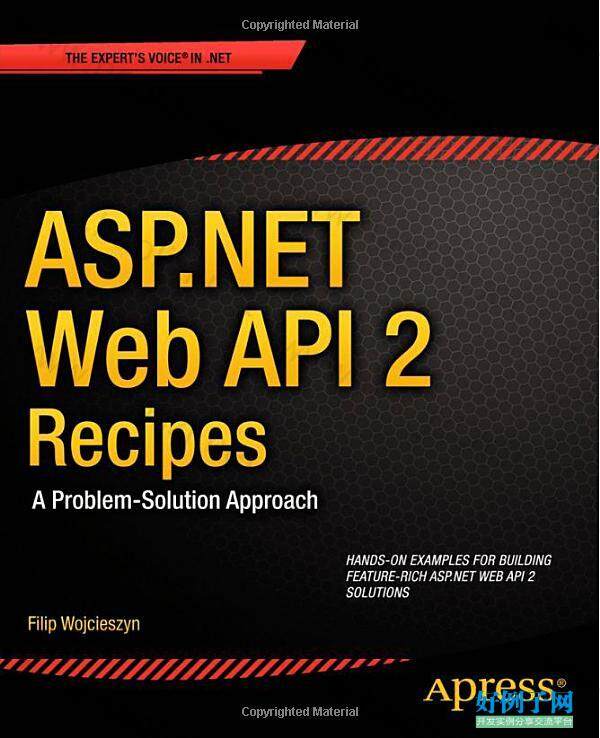实例介绍
【实例简介】
Chapter 1: Web API in ASP.NET
- 1-1 Add ASP.NET Web API to an MVC Application
- 1-2 Add ASP.NET Web API to a Web Forms Application
- 1-3 Accept an HTML Form
- 1-4 Link from MVC Controller to API Controller and Vice Versa
- 1-5 Use Scaffolding with ASP.NET Web API
- 1-6 Add Model Validation
- 1-7 Use CSRF Protection
- 1-8 Add Support for Session State
Chapter 2: Web API outside of IIS
- 2-1 Self-Host ASP.NET Web API
- 2-2 Host ASP.NET Web API with OWIN
- 2-3 Host ASP.NET Web API in Azure Mobile Services
- 2-4 Quick Prototypes with scriptcs
- 2-5 Host ASP.NET Web API in Azure Worker Role
- 2-6 Use ASP.NET Web API with F#
Chapter 3: Routing
- 3-1 Define Centralized Routes
- 3-2 Define Direct Routes
- 3-3 Set Default Route Values
- 3-4 Set Optional Route Values
- 3-5 Set Route Constraints
- 3-6 Define RPC Style Routes
- 3-7 Create Catch-all Routes
- 3-8 Prevent Controller Methods from Inadvertently Becoming Web API Endpoints
- 3-9 Configure Route-Specific Message Handlers
- 3-10 Ignore Roues
- 3-11 Localize routes
- 3-12 Generate a Link to the Route
Chapter 4: Content Negotiation and Media Types
- 4-1 Request a Specific Media Type from ASP.NET Web API
- 4-2 Supporting Additional Media Types
- 4-3 Control Model Binding From URI and Body
- 4-4 ASP.NET MVC-style Parameter Bindingin ASP.NET Web API
- 4-5 Customize XML and JSON Responses
-
4-6 Write Your Own MediaTypeFormatter
- 4-7 Run Content Negotiation Manually
- 4-8 Bypass Content Negotiation
- 4-9 Control Media Types with MediaTypeMappings
- 4-10 Serve Binary Data from Web API
- 4-11 Accept File Uploads
- 4-12 Enable Bufferless Uploads
-
4-13 Validate File Uploads
Chapter 5: Configuration and Customization
- 5-1 Throttle ASP.NET Web API Calls
- 5-2 Use Controllers from an External Assembly
- 5-3 Use Controller-Scoped Configuration
- 5-4 Validate Input with Action Filters
- 5-5 OVerride Filters
- 5-6 Add Caching to ASP.NET Web API
- 5-7 Use an Existing Caching Library
- 5-8 Order Filter Execution with Custom Filters
- 5-9 Order Filter Execution Without Custom Filters
- 5-10 Customize Error Detail Policy
- 5-11 Return HTML from Web API
- 5-12 Store Objects for the Duration of HTTP Request
Chapter 6: Embrace HTTP with Web API
- 6-1 Work Directly with HttpRequestMessage
- 6-2 Support Partial GET
- 6-3 Support the HEAD Verb
- 6-4 Support the PATCH Verb
- 6-5 Support Batching of HTTP Requests
- 6-6 Automatic HTTP 406/Not Acceptable Server Responses
- 6-7 Implement Versioning of a Web API with Centralized Routes
- 6-8 Implement Versioning of a Web API with Attribute Routing
- 6-9 Use Custom HTTP Content
Chapter 7: Exceptions, Troubleshooting and Documenting
- 7-1. Handle Exceptions with Filters
- 7-2. Handle Exceptions Globally
- 7-3. Log Exceptions Globally
- 7-4. Add a Tracer
- 7-5. Use an External Tracer
- 7-6. Call the Tracer Manually
- 7-7. Write a Real-time Tracer
- 7-8. Create a Documentation Page for ASP.NET Web API
- 7-9. Add Custom Samples to ASP.NET Web API Help Page
- 7-10. Add Filters Information to ASP.NET Web API Help Page
- 7-11. Support Data Annotations in ASP.NET Web API Help Page
Chapter 8: Cross Domain and Push Communictation
- 8-1 Use JSONP in ASP.NET Web API
- 8-2 Use CORS in ASP.NET Web API
- 8-3 Create Custom CORS Policies
- 8-4 Support Streaming and Push from ASP.NET Web API
- 8-5 Support Server-Sent Events in ASP.NET Web API
- 8-6 Integrate ASP.NET SignalR into ASP.NET Web API controllers
- 8-7 Use WebSockets with ASP.NET Web API
Chapter 9: Dependency Injection
- 9-1. Inject Dependencies into ASP.NET Web API Controllers
- 9-2. Add Support for Most Popular DI Containers
- 9-3. Deal with Request Scope
- 9-4. DI with Other Web API Components
- 9-5. Write a Custom DI Adapter (TinyIoC)
Chapter 10: Securing an ASP.NET Web API Service
- 10-1 Use Correct Web API Components for Security-Related Tasks
- 10-2 Add HTTPS Support to ASP.NET Web API
- 10-3 Use Basic Authentication
- 10-4 Integrate Windows Authentication
- 10-5 Use the Hawk Authentication Scheme
- 10-6 Use OAuth 2.0 with ASP.NET Web API (basic embedded authorization server)
- 10-7 Safely Access Current IPrincipal
- 10-8 Remove ASP.NET Web API Server Footprint
Chapter 11: Testing Web API Services
- 11-1 Unit Test ASP.NET Web API Controllers
- 11-2 Unit Test Message Handlers
- 11-3 Unit Test Action Filters
- 11-4 Unit Test Formatters
- 11-5 Simplify Tests with IHttpActionResult
- 11-6 Test Routes
- 11-7 Integration Testing
- 11-8 Integration Testing with OWIN
Chapter 12: OData (v4)
- 12-1 Creating OData Services in Web API
- 12-2 Manage OData Routes
- 12-3 Enable OData Queries
- 12-4 Support OData Functions and Actions
【实例截图】

好例子网口号:伸出你的我的手 — 分享!
相关软件
小贴士
感谢您为本站写下的评论,您的评论对其它用户来说具有重要的参考价值,所以请认真填写。
- 类似“顶”、“沙发”之类没有营养的文字,对勤劳贡献的楼主来说是令人沮丧的反馈信息。
- 相信您也不想看到一排文字/表情墙,所以请不要反馈意义不大的重复字符,也请尽量不要纯表情的回复。
- 提问之前请再仔细看一遍楼主的说明,或许是您遗漏了。
- 请勿到处挖坑绊人、招贴广告。既占空间让人厌烦,又没人会搭理,于人于己都无利。
关于好例子网
本站旨在为广大IT学习爱好者提供一个非营利性互相学习交流分享平台。本站所有资源都可以被免费获取学习研究。本站资源来自网友分享,对搜索内容的合法性不具有预见性、识别性、控制性,仅供学习研究,请务必在下载后24小时内给予删除,不得用于其他任何用途,否则后果自负。基于互联网的特殊性,平台无法对用户传输的作品、信息、内容的权属或合法性、安全性、合规性、真实性、科学性、完整权、有效性等进行实质审查;无论平台是否已进行审查,用户均应自行承担因其传输的作品、信息、内容而可能或已经产生的侵权或权属纠纷等法律责任。本站所有资源不代表本站的观点或立场,基于网友分享,根据中国法律《信息网络传播权保护条例》第二十二与二十三条之规定,若资源存在侵权或相关问题请联系本站客服人员,点此联系我们。关于更多版权及免责申明参见 版权及免责申明



网友评论
我要评论